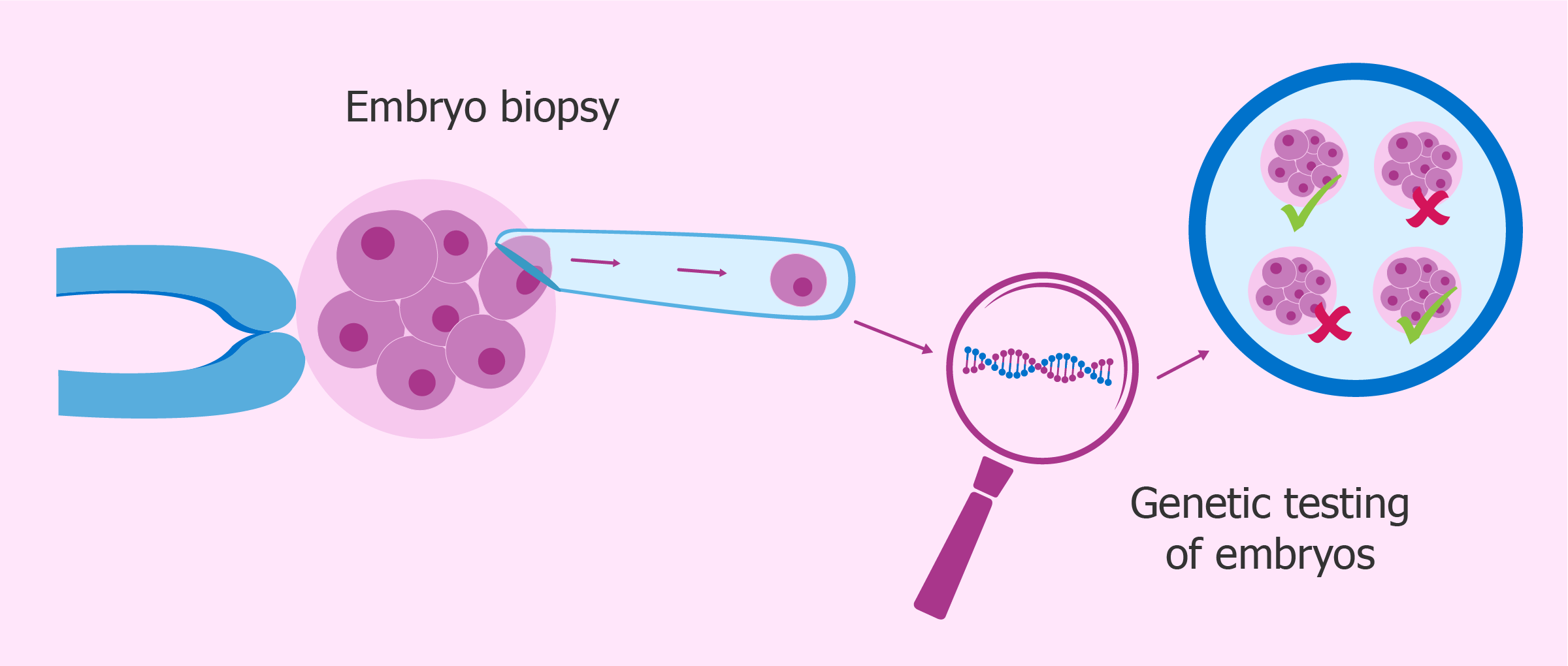Preimplantation genetic diagnosis is a procedure in which genetic defects in an embryo are identified before implantation. This is done to prevent certain genetic diseases or disorders from being passed on to the child. In PGD the embryos are usually created during the process of in vitro fertilization (IVF).
How Is The PGD Performed?
Preimplantation genetic diagnosis begins with the process of in vitro fertilization in which eggs are taken out from the body and fertilized in a laboratory. The embryos will divide into multiple cells in the next three to five days.
Following are the steps which are involved in preimplantation genetic diagnosis:
- In the first step, a couple/few cells from the embryo are microsurgically removed which are about 5 days developed. The embryos are then safely frozen after this collection.
- To determine if the inheritance of a problematic gene is present in each embryo the DNA of the cells is evaluated. This process takes at least one full week.
- When embryos are identified free of genetic problems by PGD, the embryo(s) will be placed in the uterus (usually by an IVF procedure), and then wait for implantation and a positive pregnancy test.
- Embryos with the problematic gene(s) are destroyed and additional embryos that are free from genetic problems are kept frozen for later use. This testing process may take weeks.
This process which starts from the egg retrieval process to the final results of PGD can take several weeks. This process includes the collection, fertilization, 3-5 days of development, 1-2 weeks of testing, and scheduling an appointment to discuss results with the doctor.
Who can benefit from PGD?
Any couple at risk for passing on a genetic disease or condition can get benefit from a preimplantation genetic diagnosis.
Type of individuals who are possible candidates for PGD are as follows:
- In those who are carriers of sex-linked genetic disorders
- In carriers of single-gene disorders
- Those who have chromosomal disorders
- Women age 35 and above 35
- In women who experience recurrent pregnancy loss
- In those women who have more than one failed fertility treatment
For gender selection also PGD is used. There is an ethical concern for many people when embryos are discarded based only on genetic consideration.
What Are The Benefits of PGD?
Following are the benefits of the PGD :
- More than 100 genetic conditions can be identified by PGD.
- This procedure allows couples to wish they want to continue pregnancy because it is performed before the implantation.
- The procedure enables the couple to pursue biological children.
- It helps in the identification of abnormal embryos and prevents the transfer of unhealthy embryos to the uterus.
- This procedure identifies healthy embryos which reduce the risk of multiple pregnancies.
- When a couple has inherited genetic disorders then PGD reduces the risk of having children affected with the same problems.
- PGS techniques help to select chromosomally normal embryos and will rule out those embryos which would never be capable of giving birth to the normal baby even when their appearance suggests that the embryos are of good quality.
- There are certain chromosomal abnormalities which prevent the development of the embryo in its early stages and also prevent implantation of the embryo in mother’s uterus, PGS (preimplantation genetic screening) will rule out this.
- This procedure helps to avoid the transfer of the embryos which leads to loss of pregnancy and gives birth to children with a variety of genetic disorders.
- By PGS we know which embryos will give rise to full-term pregnancy this will reduce the time required to get pregnant.
- There is a positive impact on the psychology of patient because it will ensure that the embryo is healthy and also reduce risk of pregnancy loss and this will further reduce emotional stress especially in those patients who have gone through this.
What Are The Concerns of PGD?
Following are the concerns and disadvantages of PGD:
- Many people believe that the destruction of an embryo means the destruction of a person.
- PGD reduces the chances of conception with genetic disorders but this procedure cannot eliminate this risk so, further testing is required.
- It does not replace the recommendation of prenatal testing.
- It is an invasive procedure in which an embryo needs to be biopsied to carry out genetic tests. When a biopsy of the embryo is carried out on the 5th day of development then it does not have any negative impact on embryos viability.
- Mother’s of advanced age are at high risk of having abnormal embryos, PGS analysis, in this case, will show that all the embryos are abnormal and are not suitable for transfer then this will emotionally disturb a mother.
- We accept that the biopsy sample taken from embryo represents the whole embryo because in PGS only the outer section of the embryo is taken to leave the inner part intact. This is so because scientists believe that there is a connection between both parts and the inner part gives rise to the baby.
- Due to ethical and emotional reasons, many couples have difficulty in taking decisions to analyze their embryos.
Risks of preimplantation genetic diagnosis or screening
- There are risks of ovarian hyperstimulation syndrome, multiple pregnancies, and increased risk of birth defects because PGS and PGD require in vitro fertilization.
- Biopsy and freezing harm the embryo.
- These tests show that there are no normal embryos to transfer.
- There is no guarantee of a healthy baby because tests do not screen for all the genetic diseases or disorders.
- There are increased risks of pelvic infection, miscarriage, ectopic pregnancy, etc.
- Baby’s born by IVF are premature and low birth weight babies.
If a woman is interested in PGD then she should consult with her doctor, genetic counsellor, or fertility specialist to know all other options.
Conclusion
After knowing all the advantages and disadvantages of PGS, we can conclude that it is better to use PGS in assisted reproductive techniques because it improves the success rate of the treatment.
Sources:













